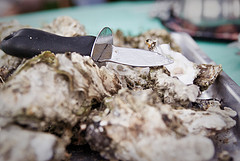Aww, Shucks: Foodborne Illnesses Linked To Eating Raw Shellfish Are On The Rise
Now is probably not the time to be so selfish when eating shellfish: New numbers from the Centers for Disease Control and Prevention say food-borne illnesses related to eating raw shellfish are on the rise. And it’s not because such seafood is becoming less safe, it’s likely due to the fact that we can’t stop gobbling shellfish down in large quantities.
An increase in foodborne illnesses linked to eating raw shellfish of 43% in 2012 might make you reconsider chowing down at that all-you-can-eat oyster shack down by the shore this summer, notes MarketWatch. The CDC’s new report compared the 2012 numbers to a period between 2006 and 2008 to arrive at that 43% increase.
Eating raw shellfish might in fact be safer than it’s ever been, say industry experts, but Americans are just so demanding these days and apparently can’t stop gobbling down raw oysters and the like.
What’s worse, explains Bob Rheault, executive director of the East Coast Shellfish Growers Association, is that the people dropping oysters down their gullets by the dozen could be the same people who should be cooking them first instead — the older, white male set — due to weakened immune systems from chronic conditions like liver disease.
“Unfortunately a lot of our demographic is old white guys with liver failure,” Rheault tells MarketWatch. “They want their raw oysters and nobody’s going to tell them what to do.”
Another problem is that the most popular time to go to a raw bar or order up raw oysters is in the summertime, the very same season that makes it easier to get sick from shellfish. It’s harder to keep oysters cold in warm weather, creating a nice cozy environment for bacteria to grow… and grow, and grow: In 80-degree heat, infection-causing vibrio bacteria can double in less than an hour, Rheault says.
If you still want to get your oyster fix, there are a few things to know: Farmed oysters tend to be trendy right now, but they’re also among the safest and often have their pedigrees listed right on the menu. But if a restaurant or raw bar can’t explain immediately where the oysters originated from or how long they’ve been out of water, that’s a warning sign.
Checking out how restaurant staff shuck oysters and watching for wide variations in size or misshapen oysters that are gaping open is also a good idea. Those are things you won’t see in a fresh, pampered oyster.
Why eating oysters is making more sick [MarketWatch]
Want more consumer news? Visit our parent organization, Consumer Reports, for the latest on scams, recalls, and other consumer issues.


